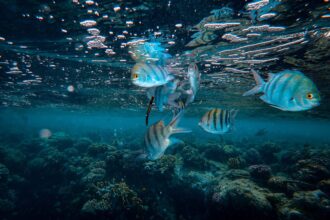B2E Technological Sonar Initiative #2
B2E presents the second edition of the new Technological Sonar initiative, our monthly selection of national and international initiatives to retain, within the scope of new patents and technologies in the blue bioeconomy sector. Check out this bunch of new inventions!
Aquaculture
- Nervous Necrosis Virus-like Particle Vaccine Stimulates European Sea Bass Innate and Adaptive Immune Responses and Induces Long-Term Protection against Disease
The rapidly increasing Mediterranean aquaculture production of European sea bass is compromised by outbreaks of viral nervous necrosis, which can be recurrent and detrimental. In this study, it was evaluated the duration of protection and immune response in sea bass given a single dose of a virus-like particle (VLP)-based vaccine. The results altogether suggested the VLP-based vaccine to be suitable for clinical testing under farming conditions.
In National Center for Biotechnology Information
Discover more here.
- Submerged feed disperser for aquaculture system
A submerged feed disperser system for an open sea fish pen is disclosed herein that increases the effective volume over which feed is delivered inside a fish pen in a submerged state. The feed disperser allows more fish to eat to satiation by reducing competition for feed, encouraging consistent fish growth within a population, while reducing aggression during feeding, and reducing the loss or waste of feed pellets during feeding.
In U.S. Patent & Trademark Office USTPO
Discover more here.
- Aquaculture feed additive
A feed additive suitable for use in commercial aquaculture, made from whole dried seaweed powder supplemented with 2.5 percent (w/w) andrographolide, increases feed conversion ratio (the ratio of weight gain to weight of feed used) and growth rate, while reducing vulnerability to water-borne marine pathogens.
In U.S. Patent & Trademark Office
Discover more here.
- Anesthesia maintenance system and anesthesia maintenance method for fish and shellfish
To reduce the toxic components in an aquarium to prevent sudden death of fishes and shellfishes, according to the present invention, in an aquarium in which fishes and shellfishes in an anesthesia state are accommodated, the concentration of carbon dioxide in the aquarium is adjusted to promote a reaction of ammonia (NH3) into ammonium ions (NH4+). An aeration means can be used to adjust the concentration of carbon dioxide.
In European Patent Register.
Discover more here.
- Fish farm material handling
Methods, systems, and apparatuses, including computer programs encoded on a computer-readable storage medium for fish farm material handling are described. Fish farm material includes samples collected from broodstock individuals and transported for suspension in cold storage. During the time window of cold storage, a metric of interest corresponding to the fish farm material is identified. Based on the metric of interest identification, material handling may be modified to, for example, segregate fish farm material into quarantined incubation units to inhibit infection of fish farm material within other incubation units.
In World Intellectual Property Organization
Discover more here.
Living Marine Resources
- Cooked Fish Substitute
The present invention relates to the field of fish substitutes, more specifically to a method for obtaining an additive-free cooked fish substitute having a fibrous texture; a maritime, iodized, salty and fresh taste; with long life; a richness in fibers, proteins and unsaturated fatty acids. The present invention also relates to this cooked fish substitute and to its use as a substitute for canned tuna or salmon.
In World Intellectual Property Organization
Discover more here.
- Environment-friendly composite basalt fiber reef base grid suitable for coral reef substrate restoration and restoration method
An environment-friendly composite basalt fiber reef base grid suitable for coral reef substrate restoration and a restoration method, comprising a square grid woven by gel-free basalt fibers. It includes pure aluminum wires and gel-free basalt fiber. The environment-friendly composite basalt fiber reef base grid has been applied to ecological restoration engineering of coastal reefs and islands in the tropical zone of the South China Sea. The accumulated restoration area reaches 4000 m 2, and a good restoration demonstration effect is obtained.
In World Intellectual Property Organization
Discover more here.
8. Automated identification of fish filets
One disclosed method involves encoding an acquired image of a fish filet into a first feature vector consumable by at least one predictive model, processing, with at least one predictive model, the first feature vector to identify a type of fish from which the fish filet was cut and causing at least one device to output an indication of the type of fish identified by the at least one predictive model. Another disclosed method involves associating first images of fish filets with metadata indicative of one or more types of fish from which the fish filets were cut, using the first images and the metadata to train at least one predictive model to categorize second images of fish filets into the one or more types of fish, and providing at least one predictive model to at least one device so as to enable at least one device to output an indication of the one or more types of fish-based acquired images of fish filets.
In World Intellectual Property Organization
Discover more here.
Marine Biotechnology
- Use of phycobiliprotein (PBP) to inhibit or treat sars-cov-2 infection
The present invention relates to the use of phycobiliprotein (PBP) to inhibit or treat SARS-CoV-2 infection and COVID 19. Phycobiliproteins are water-soluble proteins present in cyanobacteria and certain algae (rhodophytes, cryptomonads, glaucocystophytes).
In World Intellectual Property Organization
Discover more here.
10. Yemoja Uses Red Microalgae to Develop “Bleeding” Burgers
Yemoja, a marine ingredient startup from Israel, has developed bleeding vegan burgers using a red microalgae formulation. The innovation paves the way for medium-rare style plant-based burgers and steaks with added authenticity, as well as a clean substitute to heme.
In Vegconomist
Discover more here.
11. Male order: how frozen sperm can improve aquaculture genetics trade
Compiling banks of frozen fish and crustacean sperm could help to keep Australian aquaculture producers competitive, according to new research from James Cook University.
In The Fish Site
Discover more here.
12. A Fish Called CRISPR: Blocking Melanin to Boost Commercial Demand for Tilapia
Scientists at Israel’s Agricultural Research Organization, Volcani Center in Rishon Lezion, have used CRISPR-Cas9 genome editing tools to create a new strain of tilapia that does not develop suspicious blotches on their skin and instead acquires appealing, uniform, red skins that drive up their commercial value.
In Genetic Engineering & Biotechnology News
Discover more here.
13. Can a mussel-based sensor warn farmers of water quality concerns?
Using of a bivalve as a biological sensor, rather than relying purely on expensive technology. IntegraSEE’s CEO, Lawrence Taylor, explains how monitoring the behaviour of a handful of mussels in a MarineCanary unit can alert aquaculture operators to water quality issues, including pollution, pathogens and temperature anomalies.
In The Fish Site
Discover more here.





